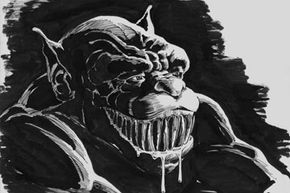How to Become a Ghoul
Where do ghouls come from? Rest assured the answer is grim. Scholars propose four schools of thought on the matter of this creature's unnatural genesis.
Born ghouls: To be sure, both male and female ghouls exist and may even exhibit carnal desires, but their sexual encounters seem to rarely result in offspring. Brian McNaughton writes that such progeny are "typically formless things" and generally consumed immediately by their mothers. While the author's book of short stories "The Throne of Bones" deals in part with the birth of a rare ghoul-human hybrid, the creature barely survives the envious wrath of its fellow ghouls.
Advertisement
Creationist ghouls: In the older cycles of myth and folklore, ghouls are just one form of evil spirit in a cosmology already teeming with them. Islamic tradition, for instance, classifies ghouls as yet another form of djinn (or jinn), supernatural and malevolent beings that rebelled against their creator Allah.
Causal ghouls: In other version of the myth, all ghouls are former humans who transformed into their current state due to wickedness or morbidity. In some accounts, the person rises as a ghoul after death. In others, he or she becomes a ghoul after dining on human flesh -- a cultural taboo often linked to monstrous transformations. In either case, the transformation is permanent and linked directly to the state of the soul or psyche. That change may occur as a divine punishment for particularly debased people.
Pathogenic ghouls: This school of thought spins ghouldom as a supernatural infectious disease -- not unlike vampirism or various zombie viruses. The disease is known as ghoul fever in Dungeons and Dragons and Porfat's distemper in Brian McNaughton's "The Throne of Bones." Whatever its human name, the condition debilitates the victim until he or she turns into a ghoul or dies and rises again as one. In most cases, the infection is transmitted through a ghoul's bite, but some legends speak of vaguer origins. In Robert Barbour Johnson's creepy short story "Far Below," subway workers beneath New York City begin to transform into ghouls, perhaps due to their proximity to unwholesome, supernatural forces in the Earth.
If these theories solve the questions of where ghouls come from, they also raise the question of their demise. Like other undead and supernatural creatures, ghouls live long, unnatural lives but are ultimately susceptible to death. Various human weapons prove effective in modern tales, but some Arabic texts stress that only a single blow from a mighty sword will do the trick. If the ghoul traps its would-be slayer into landing a second blow, then "he will not die, but will live and destroy us" [source: Al-Rawi]. Sunlight and readings from the Quran are also harmful to ghouls.
What kind of society could possible emerge among such vile creatures? On the next page, we'll look at ghoul culture.
